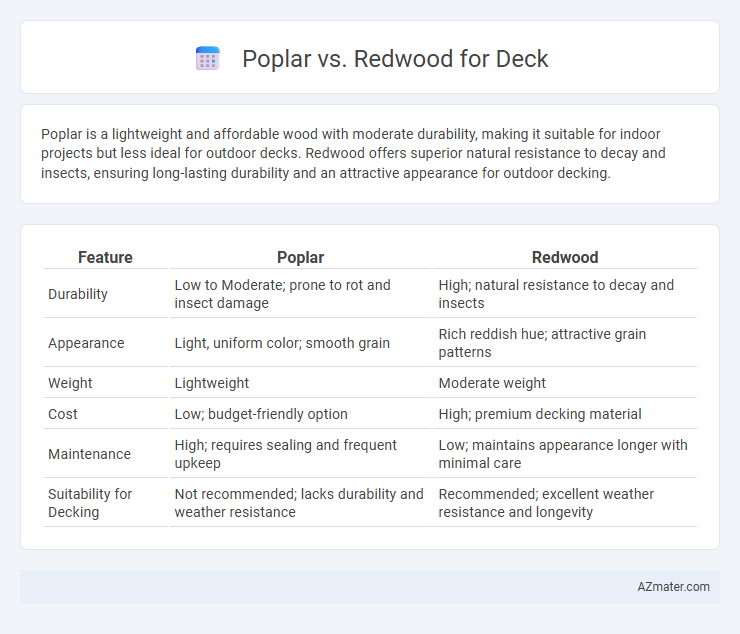Poplar is a lightweight and affordable wood with moderate durability, making it suitable for indoor projects but less ideal for outdoor decks. Redwood offers superior natural resistance to decay and insects, ensuring long-lasting durability and an attractive appearance for outdoor decking.
Table of Comparison
| Feature | Poplar | Redwood |
|---|---|---|
| Durability | Low to Moderate; prone to rot and insect damage | High; natural resistance to decay and insects |
| Appearance | Light, uniform color; smooth grain | Rich reddish hue; attractive grain patterns |
| Weight | Lightweight | Moderate weight |
| Cost | Low; budget-friendly option | High; premium decking material |
| Maintenance | High; requires sealing and frequent upkeep | Low; maintains appearance longer with minimal care |
| Suitability for Decking | Not recommended; lacks durability and weather resistance | Recommended; excellent weather resistance and longevity |
Introduction to Poplar and Redwood for Decking
Poplar is a lightweight hardwood known for its smooth texture and affordability, making it a popular choice for indoor decking projects due to its moderate durability and ease of staining. Redwood, on the other hand, stands out for its natural resistance to decay and insects, with a rich reddish hue that enhances outdoor decks' visual appeal and longevity in various climates. Both woods offer unique characteristics, but Redwood's superior weather resistance makes it ideal for exterior decking where durability and natural beauty are paramount.
Wood Characteristics: Poplar vs Redwood
Poplar wood is lightweight and smooth with a fine, straight grain, making it easy to work with but less resistant to outdoor elements compared to redwood. Redwood features a natural reddish hue, high durability, and excellent resistance to decay and insect damage, ideal for outdoor decking. The denser, more stable structure of redwood also provides greater longevity and strength under weather exposure in contrast to the softer, more porous poplar.
Durability and Longevity Comparison
Poplar offers moderate durability with a Janka hardness of 540 and resists decay poorly, making it less suitable for outdoor decks exposed to moisture. Redwood, particularly heartwood, has high natural resistance to rot and insects, with a Janka hardness around 420, ensuring superior longevity and durability in deck applications. Choosing redwood provides a longer-lasting, low-maintenance exterior material compared to poplar, which typically requires extensive treatment and maintenance to withstand outdoor conditions.
Resistance to Rot and Insects
Poplar wood exhibits moderate resistance to rot and insect damage, making it less durable for outdoor deck applications compared to Redwood. Redwood contains natural tannins and oils that provide superior resistance to decay and insect infestation, ensuring greater longevity in exterior environments. For decks exposed to moisture and pests, Redwood is generally the preferred choice due to its enhanced durability and low maintenance requirements.
Maintenance Requirements
Poplar decks require frequent sealing and staining to prevent moisture damage and maintain appearance, as the wood is relatively soft and susceptible to decay. Redwood, naturally resistant to rot and insects due to its high tannin content, demands less frequent maintenance, typically involving occasional cleaning and resealing every few years. Choosing redwood reduces long-term upkeep costs and effort compared to poplar's more intensive maintenance schedule.
Aesthetic Appeal and Color Variations
Poplar offers a smooth, light-colored surface that can be easily stained to mimic more expensive hardwoods, making it a versatile choice for decks seeking a refined and clean aesthetic. Redwood features natural reddish-brown hues with rich grain patterns that deepen over time, providing a warm, rustic charm ideal for outdoor environments. While poplar's color variations depend largely on staining choices, redwood displays consistent color tones with natural variation that enhances its organic beauty.
Cost Differences: Poplar vs Redwood
Poplar decks generally cost less than redwood decks due to the lower price of poplar lumber and its wider availability. Redwood features natural resistance to decay and insects, which can justify its higher upfront cost, whereas poplar requires treatment or sealing to improve durability, potentially adding to maintenance expenses. Over time, the lower initial cost of poplar may be offset by increased upkeep, making redwood a more cost-effective choice for long-term deck investment.
Environmental Impact and Sustainability
Poplar wood is a fast-growing species with a lower environmental footprint due to its rapid replenishment and sustainable forestry practices. Redwood, while naturally rot-resistant, grows slower and often comes from old-growth forests, raising concerns about habitat disruption and carbon sequestration loss. Choosing poplar for decking supports sustainable timber production and reduces deforestation impacts compared to harvesting redwood.
Suitability for Various Climates
Poplar is best suited for moderate climates due to its susceptibility to moisture and insect damage, making it less ideal for outdoor decks in humid or wet regions. Redwood offers superior durability and natural resistance to rot, decay, and insects, which ensures long-lasting performance in diverse climates, including coastal and rainy areas. Choosing redwood for decking provides enhanced weather resistance and stability, making it a preferred option for decks exposed to varying environmental conditions.
Choosing the Best Wood for Your Deck
Poplar is a budget-friendly softwood with moderate durability, making it suitable for indoor or covered decks but requiring protective finishes against moisture and insects. Redwood offers superior natural resistance to decay and insects, boasting a rich color and fine grain that enhances outdoor deck aesthetics and longevity with less maintenance. Choosing between Poplar and Redwood depends on your budget, exposure to elements, and desired durability, with Redwood typically preferred for long-lasting, weather-resistant decks.

Infographic: Poplar vs Redwood for Deck
 azmater.com
azmater.com